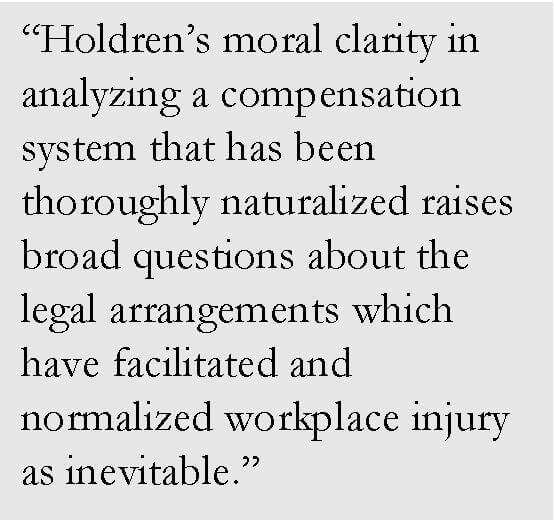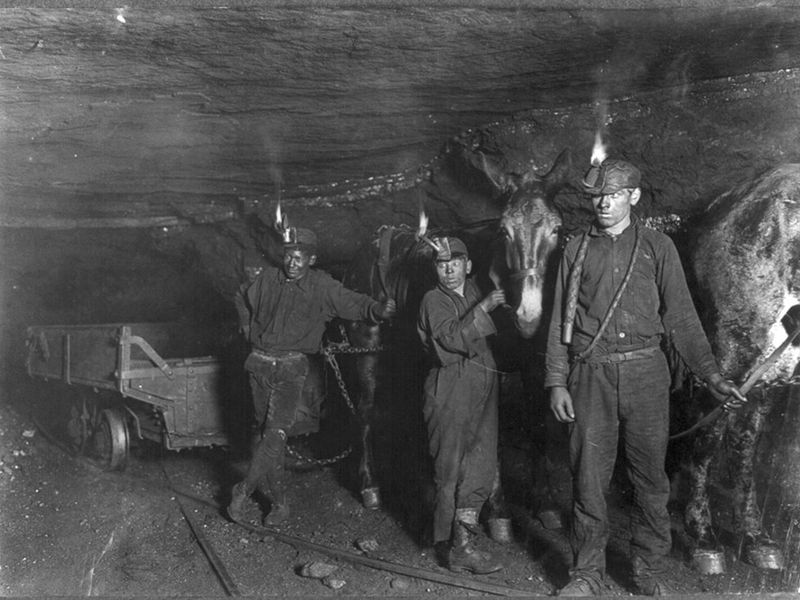Today Trish Kahle weighs in on our roundtable on Nate Holdren’s Injury Impoverished: Workplace Accidents, Capitalism, and Law in the Progressive Era, just published from Cambridge University Press. Holdren delves into the history of the emergence of workers’ compensation law in the United States. Eileen Boris introduced the series. Yesterday Vilja Hulden discussed the gap between reforms and the situations they are meant to correct.
******************
Most of us probably know what it means to be “injured on the job”—or we think we do. A belt snaps while we are next to a machine, and it gashes your face. You need stitches, but fortunately you were wearing safety glasses, and your eyes are safe. You use mislabeled chemicals while cleaning a confined space. They irritate your respiratory system, and you miss three days of work struggling to draw a breath. Sometimes injuries can seem mundane, like the carpal tunnel syndrome acquired from incessant typing with improper equipment. Still others, like those resulting from refinery explosions, are attention-grabbing: the initial blast that shakes the surrounding buildings followed by a thick plume of black smoke that signals something has gone horribly wrong. Still, whether banal or conspicuous, these injuries fall into set legal architecture meant to compensate workers for injuries on the job.
 Nate Holdren’s new book, Injury Impoverished, denaturalizes the system of workers’ compensation. He shows how struggles to define the meaning and scope of injury in the courts during the Progressive Era ultimately led to the creation of the worker’s compensation laws that still powerfully shape the way that we imagine workplace injuries and disability today. Holdren’s moral clarity in analyzing a compensation system that has been thoroughly naturalized raises broad questions about the legal arrangements which have facilitated and normalized debilitating workplace injury as inevitable. It also challenges labor historians to approach workplace injury, violence, disability, and death in a more expansive way—which I will return to in a moment. But most basically, this book is, as Judith Shklar put it, about “giving injustice its due.”[1]
Nate Holdren’s new book, Injury Impoverished, denaturalizes the system of workers’ compensation. He shows how struggles to define the meaning and scope of injury in the courts during the Progressive Era ultimately led to the creation of the worker’s compensation laws that still powerfully shape the way that we imagine workplace injuries and disability today. Holdren’s moral clarity in analyzing a compensation system that has been thoroughly naturalized raises broad questions about the legal arrangements which have facilitated and normalized debilitating workplace injury as inevitable. It also challenges labor historians to approach workplace injury, violence, disability, and death in a more expansive way—which I will return to in a moment. But most basically, this book is, as Judith Shklar put it, about “giving injustice its due.”[1]
The injustices of disability from workplace injury were many. In fact, under the lawsuit-based system which preceded worker’s compensation law, the injustices had hardly begun at the moment of injury. So found out Nettie Blom, a hotel laundry worker, when her hand was pulled into a machine that ironed linens with heated metal rollers. In the agonizing minutes that passed before her coworkers were able to free her hand from the machine, she probably had little sense of what awaited her: a day in court, where the technical details of liability and negligence eclipsed the pain she had suffered, the impact that losing use of her hand had on her day-to-day life, her inability to work in the same way.
The accident itself had represented one kind of injustice: the employer’s willingness to expose workers to dangerous equipment in the name of efficiency and production. After all what kind of hotel guest, presented with the choice, would sacrifice a person’s hand for a wrinkle-free sheet? But if the injury and consequent impairment itself were not enough, Nettie Blom subjected to a second injustice at the hands of what Holdren calls “the tyranny of the trial”: she lost her case. Not only did she leave without compensation, her injury was not even recognized as an injustice. In the eyes of the court, she was simply unfortunate.
But even if the singular injustices often went unrecognized, the court-based system did not foreclose the possibility. Some women disabled in the same manner as Blom won their cases, Holdren notes. Judges were people, not statistical tables, and could rule in an injured plaintiff’s favor even if most judges did not. The proceedings themselves were emotionally charged, personal stories of loss, and even when justice was denied, the fact of the trial suggested that basic questions of justice were at stake.
A combination of reformers—some interested in social justice, some motivated by the importance of working-class economic stability to the state, and others simply seeking to minimize the risk taken on by firms—recognized that the trial system was inadequate to the problem represented by workplace injury and the disabilities they caused. Social reformers sought to use statistical methods and vocabulary to make biopolitical claims about disabling workplace injurues a social problem. Business leaders, interested in avoiding both financial risk and class conflict, supported the reform of workplace injury law. Although some of the reformers interviewed disabled workers and sometimes told their stories to drive home their points, fundamentally, the individual story served as a symbol, rather than as a singular claim of a particular injustice. Reformers’ efforts to combine individual workers’ injuries into statistics, however, was an approach unsuited to meaningfully contesting the injustices of an economy premised on labor commodification. It was for precisely this reason so many employers came to support the new compensation laws. In fact, by turning a single hand—like the one that belonged to Nettie Blom—into an aggregated hand that could be represented in a table, the new compensation tables mirrored and expanded that commodification. The emerging “tyranny of the table” worked differently than the trial system. While a worker might be more likely to receive distributive justice—financial compensation—they were systematically denied the justice of recognition.

In this transformation of employee injury law, Holdren identifies a surprising origin of workplace disability discrimination. His examination of disability discrimination at Pullman builds on recent work by Sarah Rose, who argues that using “the lens of disability” allows us to better see “the critical importance of looking at the unforeseen and often ironic implementation and outcomes of public policies” like workers’ compensation.and requiring current employees who had already lost sight in one eye to wear goggles. Injury was an insurable risk rather than an injustice, a cost of doing business that could be budgeted for rather than a preventable injury that would forever alter a workers’ relationship with the social world around them. Holdren’s Injury Impoverished and Rose’s No Right to be Idle offer incredibly helpful guidance to scholars who deal with the unique challenges of writing about disabilities acquired as the result of workplace injury.
Labor historians concerned with the violence of the workplace—whether interpersonal, impersonally wrought by machines, negligence, or employer ambivalence—often work back from the moment of injury. We take note of the boss who sends a driver out in a snowstorm before she crashes through a guardrail. We think about the placement of machines that snag a worker’s hair and rip off her scalp. What comes after, is often seen as a response—collective action, retaliation by management. Holdren’s book challenges us to think more expansively about the injustices and lasting human consequences wrought by that moment of injury.
Although the dehumanizing process of commodifying labor through employment contracts and workplace practices will be familiar to labor historians, this book illuminates another important side of the story: the legal processes by which this commodification proceeded in the context of astronomical workplace injury rates. The “tyranny of the table,” Holdren convincingly argues, was not preordained. Instead, it lingers as a historical artifact of a particular series of legal-economic encounters. These compensation laws, he writes have “stabilized the market, organizing and redistributing injustice” (276). Compensation law is not about giving injustice its due, but about making the injustice of commodification invisible.
We can imagine a new system of injury law, one that is concerned not only with distributive justice, but with the question of recognition. To truly reckon with the costs of injuries, the injustices inherent in workplace violence, the personal and social practices they instill in us, requires more than an economic accounting. It would change the way we work, under what legal and economic arrangements. Holdren is understandably skeptical of the law’s capacity to meet this challenge, but nonetheless, Injury Impoverished is an important contribution to our understanding of the law’s shaping of the experience of workplace injury.
[1] Judith N. Shklar, The Faces of Injustice (New Haven: Yale University Press, 1992).
[2] Sarah F. Rose, No Right to Be Idle: The Invention of Disability, 1840s-1930s (Chapel Hill: University of North Carolina Press, 2017), especially see 111-171. Quote from 138.






